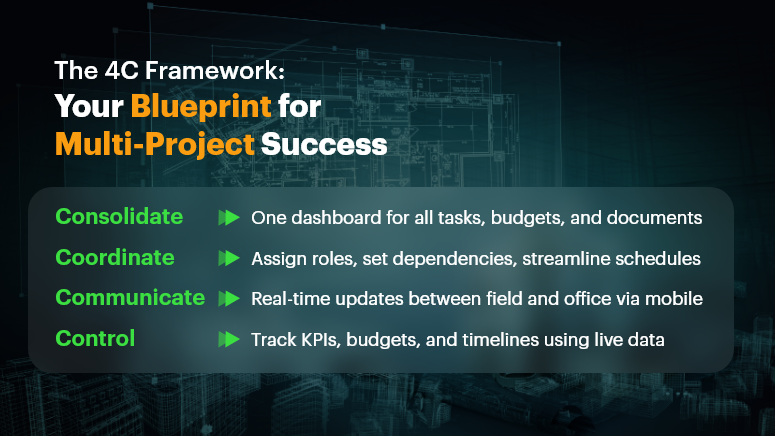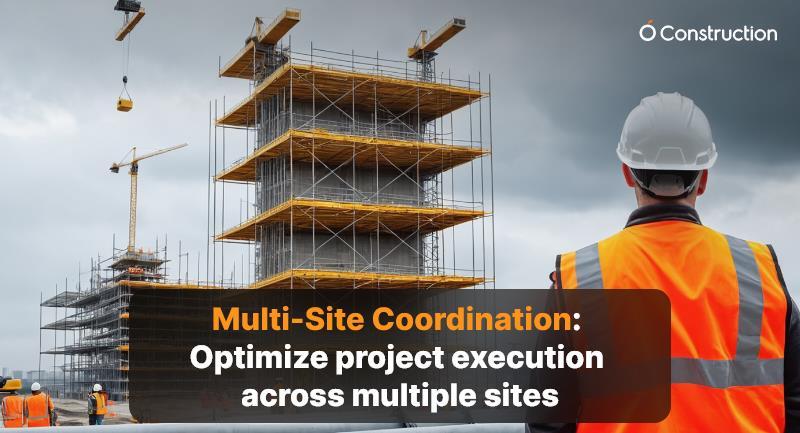Managing a single project is already a challenge — now multiply that by five, ten, or even twenty. According to a McKinsey report, large construction projects take 20% longer to finish than scheduled and are up to 80% over budget. When managing multiple construction sites, teams, and budgets at once, those risks multiply fast.
In today’s fast-paced construction world, staying in control of multiple projects isn’t just about spreadsheets and site visits anymore. It’s about having the right tools, workflows, and visibility to lead efficiently.
In this blog, we’ll walk you through how to master multi-project construction project management, avoid burnout, and use technology to gain real-time visibility — without losing your sanity.

Why Multi-Project Management Matters in Construction
Managing multiple construction projects isn’t just a bigger workload — it’s a completely different operational challenge.
The Business Case
When running multiple sites simultaneously, you’re not just managing tasks — you’re managing people, materials, permits, vendors, inspections, and client expectations across geographies. One missed update or delayed decision can create a domino effect across every other project.
That’s why modern construction businesses — especially small and mid-sized firms — must rethink how they approach construction project management. The days of tracking everything in email threads and whiteboards are over.
Real-World Scenarios
- A general contractor managing 12 residential sites loses track of which vendor was paid and who’s scheduled next on Site 7.
- An EPC firm running industrial projects across regions struggles to align budgets with live progress reports from the field.
- A design-build company tries to juggle stakeholder feedback on multiple projects but ends up reworking key deliverables due to version misalignment.
These aren’t just admin headaches. They impact your bottom line, brand reputation, and employee morale.
The solution? Centralized, real-time construction project management software that gives you clarity and control across everything you manage.
Best Practices to Manage Multiple Construction Projects Successfully
Let’s dive into proven strategies and practical frameworks that will help you gain control, reduce chaos, and make smarter decisions.
Do’s and Don’ts of Multi-Project Construction Management
- Do use a centralized dashboard.
Managing multiple projects without a unified view is like flying blind. A centralized dashboard allows you to monitor timelines, budgets, milestones, and team progress — all in one place.
- Don’t rely on manual coordination.
Emails, phone calls, and texts work until they don’t. Relying on manual updates leads to delays, miscommunication, and mistakes that cost money and trust.
- Do standardize processes across sites.
Templates for reporting, procurement, QA/QC, and daily logs create consistency. This ensures every team follows the same quality and compliance standards.
- Don’t ignore resource planning.
Overcommitting crews or duplicating material orders can cripple your schedule. Use real-time scheduling tools to balance people and inventory smartly.
Quick Wins to Regain Control
- Use mobile-first field reporting tools.
Empower your site engineers to log updates, photos, and safety reports from their phones. This reduces paperwork and ensures instant communication.
- Implement live budget tracking.
Keep track of your budget at all times. Flag overspending instantly. Tools like OConstruction help track estimates vs. actuals in real-time.
- Set up automatic alerts and reminders.
Never miss a deadline again. From permit renewals to payment approvals, get notified before things slip.
- Centralize vendor and contractor details.
Keep certifications, rates, and past performance in one place. This helps avoid repeated errors and manage accountability.
Framework: The 4C Model for Multi-Project Success
- Consolidate – Bring all projects, tasks, schedules, and documents into one platform.
- Coordinate – Assign responsibilities, dependencies, and workflows across teams.
- Communicate – Enable instant updates between the office and the field via mobile apps.
- Control – Use analytics, reports, and dashboards to monitor KPIs and correct courses fast.
This model aligns perfectly with how OConstruction structures its platform — helping teams stay connected, proactive, and accountable.
Customer Example: Real-World Success in Action
For example, FalconBuild Pvt. Ltd., a mid-sized commercial contractor, used OConstruction’s centralized dashboard and mobile reporting tools to manage 9 simultaneous projects across two states. With real-time visibility into site progress, resource allocation, and budget tracking, the team reduced reporting time by 40% and improved on-time project delivery by 30%. Here’s how…
- Deployed a mobile app for on-site daily logs and inspection checklists
- Used real-time dashboards to track material use and crew hours
- Set up auto-notifications for permit expirations and change orders
- Cut down email chains by 60% with built-in messaging and approvals
Result: More clarity, less chaos, and measurable ROI.
Regain Control, One Project at a Time
Managing multiple construction projects doesn’t have to feel like a high-stakes balancing act. With the right tools and workflows, you can reduce risk, increase productivity, and stay confidently in control.
- Centralize your project data
- Standardize your workflows
- Empower your teams with mobile access
- Use real-time dashboards to make informed decisions faster
Modern construction project management is about agility, visibility, and control — and that’s exactly what a platform like OConstruction delivers.
FAQs
1. What is multi-project construction management?
Multi-project construction management refers to overseeing several construction projects at once, ensuring timelines, budgets, resources, and teams are coordinated efficiently.
2. Why is managing multiple construction projects so challenging?
Because it involves coordinating tasks, crews, vendors, permits, and budgets across different sites. A small delay or miscommunication in one project can ripple across others.
3. How does construction project management software help with multi-project management?
It centralizes all projects into a single platform, offering real-time dashboards, resource planning, budget tracking, and communication tools that keep teams aligned.
4. What are the risks of managing multiple projects without software?
Common risks include cost overruns, delayed timelines, miscommunication between field and office, duplicate resource allocations, and low client satisfaction.
5. Can small and mid-sized construction companies benefit from multi-project management tools?
Yes. In fact, smaller firms benefit greatly since software reduces manual admin work, prevents mistakes, and helps them scale without needing large management teams.





